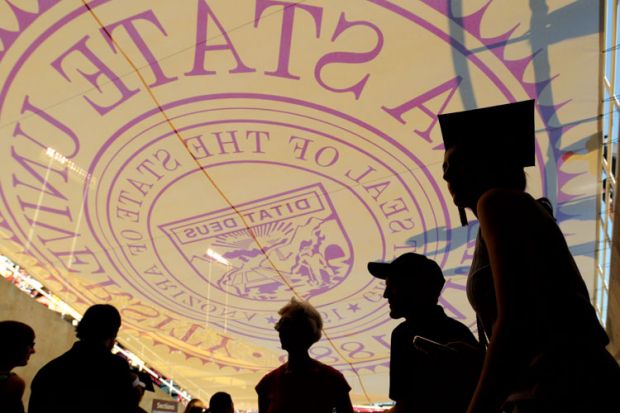Universities in the US are stymieing their own development by refusing to think outside the box, slavishly copying what other institutions do and putting too much faith in tradition, according to the head of one of the biggest in the country.
Michael Crow is president of Arizona State University, which, he says, welcomed 83,000 students on to courses this semester. His tenure, which began in 2002, has been characterised by a determination to break from the norm and to create the “New American University” – a phrase used to describe the institution’s commitment to “excellence, access and impact”.
“We [Arizona State] are not constrained by…isomorphic replication,” he says, criticising institutions that simply recreate the status quo. “[Other] universities for the most part don’t even need leaders, they just copy each other. We have moved to the notion of innovation being more important than tradition.”
Departure from the norm has meant sweeping changes. During Crow’s reign, 69 academic units, schools and departments have been, as he terms it, “eliminated” and replaced by 25 new ones. In the process, he says, 1,800 people lost their jobs. The new departments have unfamiliar names. Gone is the philosophy department. There is no school of sociology. But you will find a “School of Earth and Space Exploration”, which incorporates aspects of physics, astrobiology and astrophysics, and you could find yourself teaching in the “School of Human Evolution and Social Change”.
“There are 400 [sociology departments] somewhere else, and they’re basically in line like sled dogs,” Crow says, again dismissing uniformity as undesirable. “So you’re the 10th best sociology department in the UK, and maybe you’re the 14th best sociology department in Europe, and then between Europe and North America you’re the 21st sociology department. Who cares?”
Implementing such alternatives becomes easier “once you don’t care what anyone else thinks, and realise it really isn’t our job to be clonal,” he says. “Clonal replications lead to really bad outcomes in nature, and they lead to really bad outcomes in markets and in economies. You need more differentiation,” he reasons.
Crow also believes that tenure needs a rethink. “Tenure has become this urban myth. People think it is a lifetime appointment, a lifetime job. It’s not like that – it is a lifetime licence to pursue your ideas unencumbered by someone else who wants to see your ideas not make it.
“It doesn’t mean you don’t work, that you’re not creative, and that you can be a jerk. It’s not a licence to be a jerk.” This, he adds, is what tenure has become in some institutions.
ASU is not short on ambition. Crow sees his institution’s aims for the next six years as “nearly impossible to obtain – which we love”.
These objectives include graduating 25,000 students a year while conducting $700 million (£435 million) worth of research, which he describes as the “Massachusetts Institute of Technology level of research” – to be achieved without a medical school.
“When you take out the medical research, which we don’t have, we [already] have more funded research activity than Harvard, Stanford and Columbia,” Crow claims.
Such growth is not without precedent for ASU. The year after Crow took office, ASU graduated fewer than 9,000 students. Last year, that number had risen to about 20,000. Twelve years ago, the university conducted $100 million of research, compared with $420 million in the past 12 months.
Technology has been key in cutting costs and staff levels while “improving every metric we have” to measure success. In one example, ASU invested $10 million in an “artificial intelligence-based electronic adviser system” that tracks students’ ability in class and plots their best academic route. “We are simulating everything,” he says – allowing ASU to hire fewer student advisers but at a higher level. “You don’t want to sit with an adviser to work through your dreaming, you want to sit with an adviser and get a sense of where you are.”
Despite the reductions, ASU still employs 3,000 faculty members and 21,000 employees in total. Keeping them on side as the revolution continues will be a challenge, but it is one that Crow and the university board appear to relish. “ASU was looking for innovative approaches to scale, to cost, to all types of things,” he says. “The board is not only behind it, they now desire it.”





